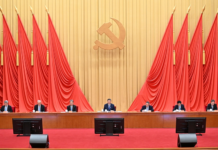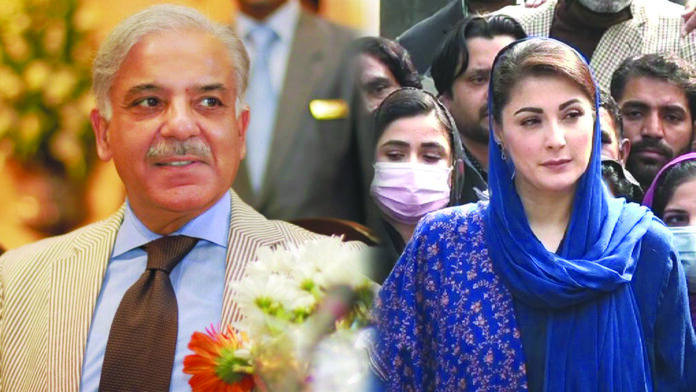AT PENPOINT
Is there a deliberate effort to make the government stumble from crisis to crisis, or is that how things are just happening? More significant, is the visible difficulty of ruling Pakistan the result of not following the logic of the result of the February 8 election?
Perhaps the most pressing problem facing the government is economic. The problem is twofold, because not only does the government have to negotiate a new deal with the IMF, but it also has to put a cap on the inflation that is making the life of the common man so difficult. Unfortunately for the government, the IMF has laid conditionalities in the past, and is likely to do in future, which will lead to hikes in the electricity, fuel and gas prices, both fuelling inflation across the board and acting as a dampener on growth.
The government has found that the attack on Chinese engineers in Dasu, which killed five, has combined with an escalation of the tension with Afghanistan, with the killing of four soldiers, including a colonel, in Tirah the result of Tehrik Taliban Pakistan action. The government responded with the bombing of a TTP camp in Afghanistan. It has also tried to mend fences with China.
Then there is the mysterious affair of the letters. At first, there was only the letter which had been sent by six judges of the Islamabad High Court to the Chief Justice of Pakistan, about interference by an intelligence agency in their work. That led to a meeting of the Prime Minister and the Chief Justice of Pakistan, the appointment by the Cabinet of a judicial enquiry commission–followed swiftly by the recusal of the person appointed, and then the Supreme Court took up the matter in its suo motu jurisdiction. This was followed by the arrival at the Supreme Court, the Islamabad High Court and the Lahore High Court of letters to various judges, all containing a white powder, labelled anthrax, though forensic testing later showed the powder contained arsenic, not anthrax spores.
While there was a fearful hubbub around the judges’ letter, with Bar Councils and Bar Associations weighing , the anthrax letters seemed to have lost attention, even though they were more dangerous. They showed that the various courts had a system of receiving mail that does not seem to be security-oriented. It showed that the various registry departments which actually received mail were vulnerable to booby traps, even if the judges seemed to be safe. They were saved not by attention to security, but by the administrative convenience which has all mail delivered to one place, with further distribution to the judges from there, after the mail was opened. It seems that boobytraps are possible.
The government should be interested, not just because it needs to ensure the independence of the judiciary, but because the mails were used. It should also be noted that there was no CCTV footage available to the post office, located in a business centre, not because there were no cameras, but because they were out of order. Either the Safe City Authority was falling down on the job, and those posting the letters were powerful indeed.
The letters, both from the judges and to them, were still the subject of great speculation, when the confrontation at Bahawalnagar occurred. It appeared that the police’s attempt to arrest the brother of an Army officer was fiercely resisted, with the ISPR noting that the colour of a confrontation between the police and the military was being created on social media. A Joint Investigation Team has been set up.
While it might seem that an old warhorse has been returned to service in the shape of the PML(N), it should be noticed that the PM and Punjab CM are entirely new. If at all history is to repeat itself, it will be after they are allowed a free run. And it is not likely that anyone will benefit, unless it is someone who is at present not in the front rank.
It should be noted that if the police raiding party was subjected to violence, its previous attitudes have been to blame. The police have a reputation for throwing their weight around. Under the Raj, when they were the ‘steel framework of the Empire’, their purpose was not so much the protection of the citizens as the preservation of the Raj. The British realised that this required the provision of justice, which it did through the police. They were allowed to use methods which violated fundamental rights. After Independence, the process of converting into free citizens is still not complete, and the police are now acquainted with the concept of fundamental rights and due process.
However, acquaintance does not mean observance. The third degree is still practised. Policing universally and historically involves policemen trying to avoid observing due process of law. Pakistan’s police forces are no exception. They also enjoy government patronage, not just from politicians, but military rulers. They are not only still the ‘steel framework’ of the state, but are relied on to ‘deal’ with political opponents. Anyone who has ruled in Pakistan has relied on the police.
Because of that, they continue to ignore fundamental rights, with the result that anyone who can claim a group solidarity, will resist arrest. When the military is involved, there is a flurry of concern that there is an institutional clash. When the Islamabad police attempted to arrest journalist Mohsin Baig in February 2022, there was a gun fired, but he was arrested. However, it did not become a press-versus-police issue, though it could well have. One reason is that press bodies are not strong or united enough.
Perhaps that is a good thing, for there are people within the press who would exploit this power. It might be noted that the Baig case occurred because the police were being pressed by the executive. In Bahawalnagar, there does not appear to be that combination of two powerful bodies gasngin up on the third.
Already, there is talk of a clash between institutions. This might be the result more of wishful thinking rather than anything else. After all, ever since 1970, power players have only come to the fore because of establishment help. The visit of President Yahya Khan in January 1971, after the December 1970 election, to Zulfikar Ali Bhutto’s Larkana estate for duck shooting came before the abortive National Assembly session in Dhaka in March, the military crackdown there, then the 1971 War and the break-up of Pakistan. The result of the election had given the Awami League an absolute majority, and Yahya went to Larkana after meeting Mujeeb earlier, but not getting any guarantees that he would continue in office. When it became impossible for Yahya to carry on after the War, Bhutto became CMLA and President.
He was removed by the military in 1977. In this time, there emerged two contenders for office: Bhutto’s daughter Benazir and Mian Nawaz Sharif. After Zia, these two alternated in office. The establishment switched from one to another, until the 1999 Martial Law.
It seemed the alternation would resume after Martial Law was lifted, but the murder of Benazir Bhutto created a new situation.. A new contender appeared, Imran Khan. His ascent to power became an inevitability, perhaps because the other volunteers had been tried before.
While it might seem that an old warhorse has been returned to service in the shape of the PML(N), it should be noticed that the PM and Punjab CM are entirely new. If at all history is to repeat itself, it will be after they are allowed a free run. And it is not likely that anyone will benefit, unless it is someone who is at present not in the front rank.























